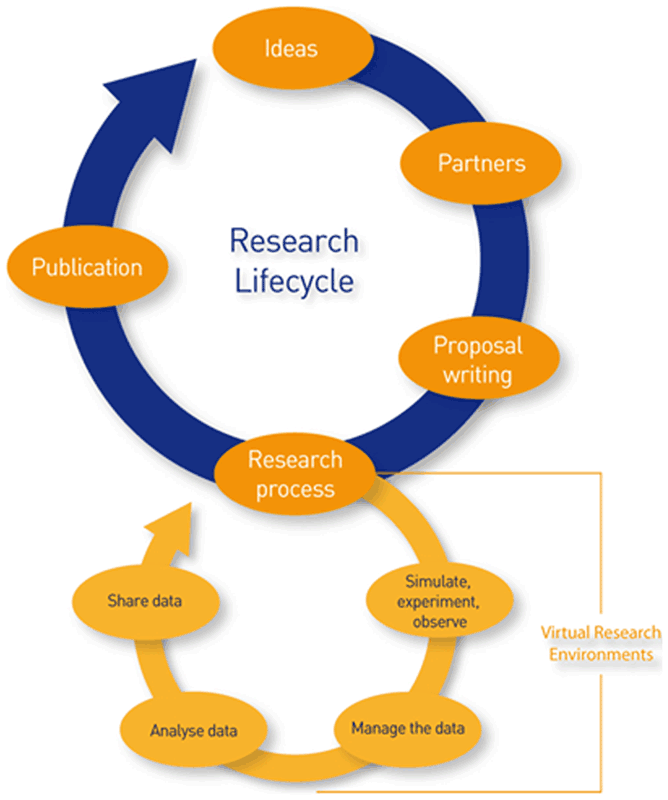by Valerie Brasse (IS4RI and euroCRIS)
The purpose of virtual research environments (VREs) is to support research stakeholders throughout the research life-cycle. In order to describe the expectations and requirements at each stage of the life-cycle, high-level use-cases have been developed in the VRE4EIC project, which has developed a Europe-wide interoperable VRE to facilitate innovation and collaboration between multidisciplinary research communities.
The goal of a virtual research environment (VRE) system is to provide support at each stage of the research life-cycle. The computing requirements will vary depending on the expected support, but commonalities can be identified.
Based on the first requirements collection in the VRE4EIC project, use-cases have been elaborated to express the possible ways in which users interact with the system. Use-cases are useful as they provide:
• Context to the requirements, expressing the requirements in terms of a concrete objective that the user wants to realise,
• Test scenarios for acceptance testing, i.e. a ‘black-box’ view of the system, what the user inputs and requires as output, unaware of the system’s internal behaviour,
• Advocacy material to demonstrate to potential VRE users and developers what the e-VRE is expected to do.
In our approach, use-cases have been expressed at two levels of granularity:
• Low level use-cases, which assemble requirements in a coherent sequence,
• High-level use-cases are expressed as an orchestration of low level use-cases.
In the first wave of use-case elicitation (a second wave is expected by the end of the project), 59 low level use-cases and 19 high-level use-cases have been identified and described. For example, at the beginning of the research lifecycle, the first stages are ‘Ideas, Partners, Proposal writing’, where ideas come up and partners get together and write proposals to get funding on research projects. On their side, funding agencies set up work programmes and funding calls, and allocate funding to the selected proposals submitted by the researchers.
The unique high-level use-case defined at this stage of the research lifecycle is named ‘Manage funding calls’. The associated actor is a ‘funding agency’, and the sequence of steps includes the suggestion to have the funding agencies publish information about themselves and their funding calls, then the agencies should retrieve the submitted proposals. Finally, the use-case provides generic requirements related to the e-VRE user interface.

Figure 1: The use-cases that were developed for the target e-VRE platform cover the full research lifecycle.
The Research process part of the research lifecycle is itself divided into four stages:
The first stage called ‘Simulate, experiment, observe’ is covered by four high-level use-cases, namely: ‘Create a dataset’, ‘Create a dataset from an instrument’, ‘Manage an instrument’, and ‘Communicate’. These use-cases are related to the data acquisition and the collaborative work done at this stage.
Still in the research process, the second stage deals with ‘Managing data’. It is covered by five use-cases related to the use and transformation of data, namely ‘Access services and data from e-VRE’, ‘Manage data’, ‘Manage research projects’, ‘Transform data’, and ‘Query data’.
The third step in the research process is called ‘Analyse data’. Five use-cases also cover it. They are ‘Access services and data from e-VRE’, ‘Annotate data’, ‘Compare datasets’, ‘Process data’, and ‘Communicate’. They are related to the analysis of data in context, and in a collaborative way.
The last step in the research process, and the last step in the research lifecycle, are about ‘Sharing data’ and the research results obtained from it, generally in the form of a scientific ‘Publication’. Three use-cases cover this part: ‘Access services and data from e-VRE’, ‘Publish dataset’, and ‘Communicate’.
Some of the use-cases, such as ‘Access services and data from e-VRE’ and ‘Communicate’, are recurrent, being used at several stages. This highlights the main characteristics of a VRE as an enabler of services and data access, and communication or collaboration amongst the research stakeholders.
As the project now goes into development, some of these use-cases will be implemented and available for acceptance testing in a further phase, in the context of enhancing current infrastructures for them to become VREs.
The following documents are available on demand:
- Y. Yin (ed.): “State-of-the-art and user requirements analysis. Deliverable D2.1 of the VRE4EIC Project.
- V. Brasse (ed.): “Use case report - First version. Deliverable D2.3 of the VRE4EIC Project.
Both available on demand by the project coordinator (see http://www.vre4eic.eu).
The project is currently carrying out a use-cases survey, which is targeted at anyone interacting with research data. Its purpose is to find out what researchers require in order to help them share and use data from multiple disciplines. Anyone involved in academic research activities can participate in this survey, since they might (potentially) share and/or use (open) research data. The results of this survey will be used to develop and further specify the requirements of the VRE developed in the VRE4EIC project, and will benefit future scientific research activities.
Links:
http://www.vre4eic.eu/
Survey: https://www.vre4eic.eu/publications/news/113-vre4eic-online-survey-to-evaluate-use-cases-for-a-virtual-research-environment
Please contact:
Valerie Brasse,
euroCRIS Executive for Projects, IS4RI Managing Partner











